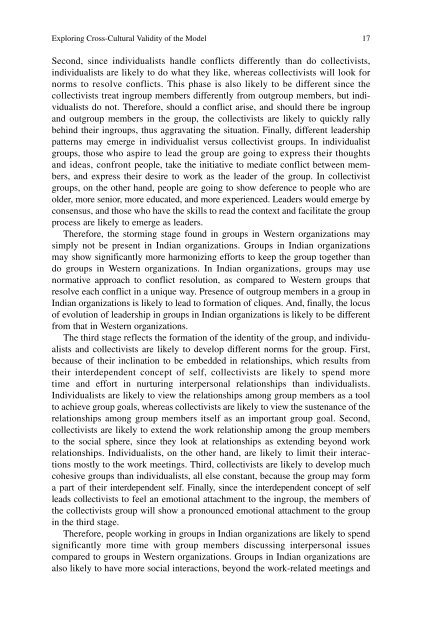Spirituality and Indian Psychology: Lessons from ... - Mandhata Global
Spirituality and Indian Psychology: Lessons from ... - Mandhata Global
Spirituality and Indian Psychology: Lessons from ... - Mandhata Global
You also want an ePaper? Increase the reach of your titles
YUMPU automatically turns print PDFs into web optimized ePapers that Google loves.
Exploring Cross-Cultural Validity of the Model<br />
Second, since individualists h<strong>and</strong>le conflicts differently than do collectivists,<br />
individualists are likely to do what they like, whereas collectivists will look for<br />
norms to resolve conflicts. This phase is also likely to be different since the<br />
collectivists treat ingroup members differently <strong>from</strong> outgroup members, but individualists<br />
do not. Therefore, should a conflict arise, <strong>and</strong> should there be ingroup<br />
<strong>and</strong> outgroup members in the group, the collectivists are likely to quickly rally<br />
behind their ingroups, thus aggravating the situation. Finally, different leadership<br />
patterns may emerge in individualist versus collectivist groups. In individualist<br />
groups, those who aspire to lead the group are going to express their thoughts<br />
<strong>and</strong> ideas, confront people, take the initiative to mediate conflict between members,<br />
<strong>and</strong> express their desire to work as the leader of the group. In collectivist<br />
groups, on the other h<strong>and</strong>, people are going to show deference to people who are<br />
older, more senior, more educated, <strong>and</strong> more experienced. Leaders would emerge by<br />
consensus, <strong>and</strong> those who have the skills to read the context <strong>and</strong> facilitate the group<br />
process are likely to emerge as leaders.<br />
Therefore, the storming stage found in groups in Western organizations may<br />
simply not be present in <strong>Indian</strong> organizations. Groups in <strong>Indian</strong> organizations<br />
may show significantly more harmonizing efforts to keep the group together than<br />
do groups in Western organizations. In <strong>Indian</strong> organizations, groups may use<br />
normative approach to conflict resolution, as compared to Western groups that<br />
resolve each conflict in a unique way. Presence of outgroup members in a group in<br />
<strong>Indian</strong> organizations is likely to lead to formation of cliques. And, finally, the locus<br />
of evolution of leadership in groups in <strong>Indian</strong> organizations is likely to be different<br />
<strong>from</strong> that in Western organizations.<br />
The third stage reflects the formation of the identity of the group, <strong>and</strong> individualists<br />
<strong>and</strong> collectivists are likely to develop different norms for the group. First,<br />
because of their inclination to be embedded in relationships, which results <strong>from</strong><br />
their interdependent concept of self, collectivists are likely to spend more<br />
time <strong>and</strong> effort in nurturing interpersonal relationships than individualists.<br />
Individualists are likely to view the relationships among group members as a tool<br />
to achieve group goals, whereas collectivists are likely to view the sustenance of the<br />
relationships among group members itself as an important group goal. Second,<br />
collectivists are likely to extend the work relationship among the group members<br />
to the social sphere, since they look at relationships as extending beyond work<br />
relationships. Individualists, on the other h<strong>and</strong>, are likely to limit their interactions<br />
mostly to the work meetings. Third, collectivists are likely to develop much<br />
cohesive groups than individualists, all else constant, because the group may form<br />
a part of their interdependent self. Finally, since the interdependent concept of self<br />
leads collectivists to feel an emotional attachment to the ingroup, the members of<br />
the collectivists group will show a pronounced emotional attachment to the group<br />
in the third stage.<br />
Therefore, people working in groups in <strong>Indian</strong> organizations are likely to spend<br />
significantly more time with group members discussing interpersonal issues<br />
compared to groups in Western organizations. Groups in <strong>Indian</strong> organizations are<br />
also likely to have more social interactions, beyond the work-related meetings <strong>and</strong><br />
17

















